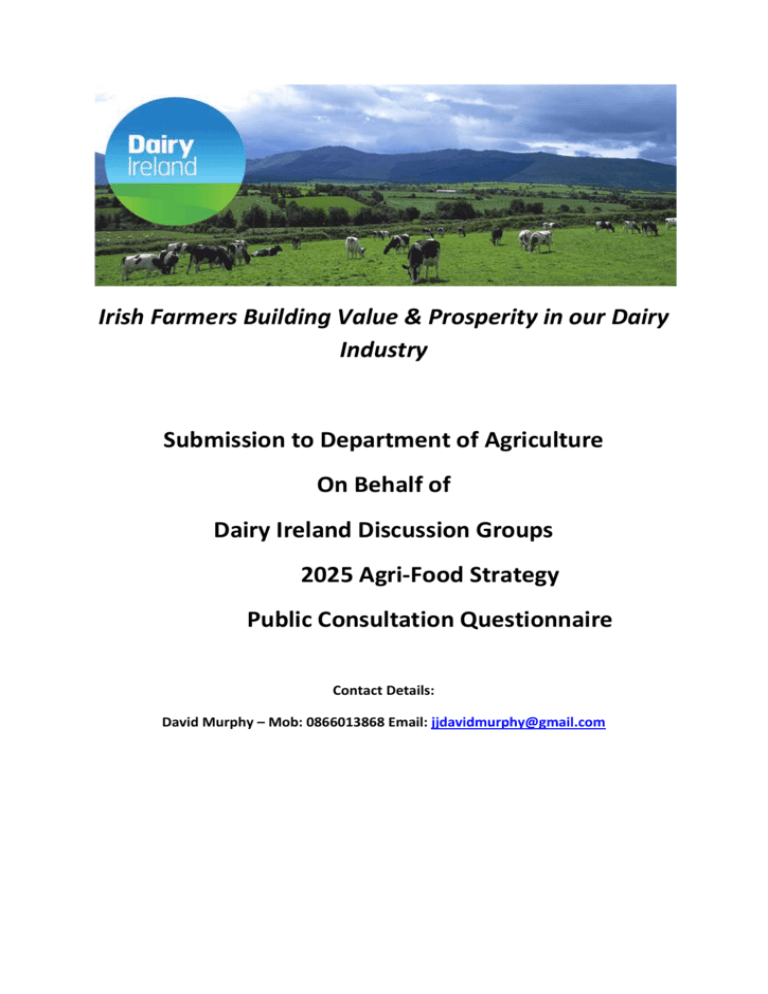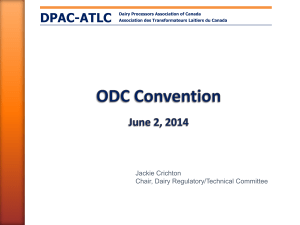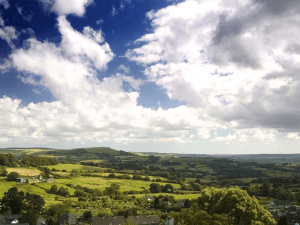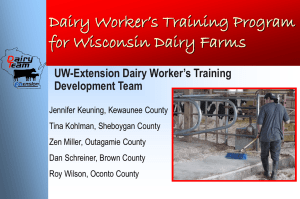Dairy Ireland Discussion Groups 2025 submission
advertisement

Irish Farmers Building Value & Prosperity in our Dairy Industry Submission to Department of Agriculture On Behalf of Dairy Ireland Discussion Groups 2025 Agri-Food Strategy Public Consultation Questionnaire Contact Details: David Murphy – Mob: 0866013868 Email: jjdavidmurphy@gmail.com Introduction We would like to start this proposal by pointing out that this is a dairy focused group and as such our submissions are largely going to be based on our knowledge of this sector but feel that they could have a wider positive effect on the agricultural industry. The objective of the 2025 Agri-Food Strategic Review is to encourage our agricultural industry to grow which, in the long run, will return additional revenue to the state. Agricultural incentives and clear coherent planning of our industry targeted at business growth and increased productivity will return additional revenue through increased employment, sustainable export earnings and the multiplier effect of additional economic activity and wealth creation in the local economy. N.B. This document endeavours to answer the questions outlined in the 2025 AgriFood Strategy Public Consultation Questionnaire 1. Has Food Harvest 2020 delivered on its vision for the Agri-Food* Sector in Ireland? Questions: Are we on course to deliver on the strategy envisaged in Food Harvest 2020? How can the strategy for the agri-food sector be improved for the next decade? Are there emerging market opportunities that should be considered as part of a new strategy for the sector to 2025? What should be the scale of our ambition for the sector? Answers: In our considered opinion we are not on course to achieve the 2020 FoodHarvest targets, this is due to underinvestment in some key areas and also the imposition of certain road blocks that curtail the efficient growth of the Irish Dairy Industry. 1. Removal of recruitment ban within Teagasc to facilitate knowledge transfer and adaption of sustainable economic dairy farming models. 2. Teagasc advisors must be deployed to interface with farmers and not be consumed by form filling (skilled Teagasc discussion group facilitators must be free to advise farmers on best practice) 3. Incentivise farmers to join discussion groups (this will encourage “the late adaptors” to improve efficiency through the adaption of best practice) 4. Centralisation of Marketing, R+D and ensuring Processing Efficiency is paramount for the dairy industry to compete in a global market (all government funding needs to be focused towards co-ops and companies that are part of a National Strategic Plan that enhances efficiency across the industry – this will reduce duplication within all sectors) 5. We must continue to market our grass based production system improving the image of all Irish Food, Drink and Tourism offerings. Government and industry funding should be aimed towards a cohesive marketing strategy that covers these interlinked areas. 6. Sustainable growth of the Dairy Industry will deliver enormous economic benefits for rural Ireland with this regard a national milk pool of 10 billion litres per annum by 2025 is achievable. (Aim for in excess of 3% annual growth in Dairy output from 2020 onwardscontinues to promote rural economy - also we must out perform inflation by at least 1% ) 2. Sustainability / Climate Change Questions: How can Ireland build on existing policies and standards to promote more sustainable agriculture, forestry and fisheries and to meet our national, EU and international commitments in these areas? How do we reconcile these actions with the need to optimise food production, economic growth and job creation ? In the context of the development of the agri-food sector to 2025, what specific actions should be taken by farmers/fishermen, processors and the State on: o Greenhouse gas emissions and sequestration o Air, water and soil quality o Biodiversity o Bioenergy development o Sustainable fisheries and aquaculture 1. The Nitrates Directive must be adapted to optimise Irelands natural advantage to grow grass efficiently and to its maximum potential. This should be subject to good science using soil and water quality analysis. The adaption of Moorepark research and the promotion of best soil management systems to maximise grass growth. Encouragement of grass measuring skills amongst farmers and allowances for adequate chemical fertilizer on high growth farms with proven adaption of Teagasc best soil management systems. 2. Promote our green image abroad but also need to match our total grass output potential with livestock – this will give efficient use of our inputs and natural grass growing ability - if we don’t do it some other country will, which is less environmentally friendly and more costly. 3. The grassland hectare must be registered as a carbon sink and extra allowances made for extra grass growth per hectare. Hedgerows must also be classified as carbon sequesters in line with forestry. 4. Formation of a National Policy (one agency) encompassing soil water and air quality, this policy framework must encourage the expansion of dairy output in an environmentally and economically sustainable format. Education of farmers within this policy on the importance of biodiversity. 3. Global market context including opportunities for FDI Questions: What major changes/challenges are likely to emerge in the global market for food and drink in the period to 2025? How could Ireland be better placed to compete in the global market over the next decade? Should Ireland seek to better identify and target high value niche markets, and if so how? Should we encourage increased international investment (FDI, Joint Ventures) in our agrifood industry and/or develop strategic alliances with partners in rapidly growing markets? 1. A national and centralised policy to deal with food scares, this must encompass stringent and transparent testing at all industry levels (one weak link threatens the entire industry). Government must focus funding towards the elimination of animal diseases and support 2. 3. 4. 5. for agencies such as AHI (Animal Health Ireland) is critical in achieving a transparent disease free status. For Irelands dairy industry to progress we need a cohesive and single focus marketing agency to give us scale and momentum in existing and new dairy markets, it is paramount to reduce duplication in marketing initiatives. Implementation of focused and centralised research and development that leverages our established Kerrygold Brand. Enhance the Bord Bia Origin Green Initiative to portray Irelands green sustainable food production systems and tie in with tourist promotional strategies. Build relationships with developing countries by encouraging them to improve their own agricultural industries through sharing our own production systems knowledge incorporating training programmes for young farmers and industry operatives. Foreign Direct Investment and joint ventures should be encouraged if they are proven to be beneficial to the industry by incorporating new skills and technologies that add value to milk and enhance the value of our dairy output. Also the encouragement of farming related industries such as grass seed sourcing and blending that are beneficial to the Irish growing climate. Competitiveness & innovation Questions: What can be done to improve the competitiveness of the agri-food sector over the next decade? Are there examples of best practice from abroad that could be adopted in Ireland? What measures should be adopted at farm level to improve competitiveness? What measures should be adopted at industry level to improve competitiveness? What emerging / existing technologies might significantly impact on the agri-food sector in the years ahead? How can we maximise job creation within a competitive agri-food sector over the next ten years? What areas should we prioritise to encourage increased innovation in the agri-food sector? 1. Education: The implementation of an education programme to help produce effective leaders within Irish co-operatives. This could be implemented through ICOS, Teagasc, Universities and our dairy co-ops. All co-op board members must attain a third level qualification or similar standard to serve at board level, this should be implemented within a ten year timeframe. All agricultural colleges must integrate a co-op section in their syllabi so students have a clear understanding of milk processing and how we add value to dairy products. (Friesland Campina in the Netherlands have comprehensive education policies to identify future co-op leaders) 2. Maximise our ability to grow more grass, Teagasc has responsibility for knowledge transfer of best grassland management systems and implementation of the Moorepark model. Government funding through grant aid for land drainage and lime application. Encouragement of Big Data assimilation (disease and health information gathered through vets and factories) and channelled through ICBF to enhance the value of EBI in the national dairy herd. 3. Implement a national strategic plan for our dairy processors and identify areas of duplication that can be reduced or eliminated this plan must include a cohesive investment strategy that will lead to reduced fragmentation in the industry. 4. Whey protein technologies that add significant value to milk – government must encourage investment in these areas. Explore GM technologies on grass varieties (a technology that could revolutionise output per hectare could dramatically improve our competitivness) 5. Government must remove roadblocks that inhibit an efficient dairy farm and processing sector such as excessive development costs for farm expansion and excessive bureaucratic burdens. 6. Investment in Teagasc to ensure independent research into best farming practice that builds on economic and environmental sustainability that best suits Irish production systems. Cohesive investment in R+D to add value to Irish Dairy products. Encourage cohesive investment in marketing our dairy products. 5. Risks Questions: What do you consider the most critical risks facing the Irish agri-food sector and rank in order (1=highest risk, etc)? What measures should be taken to mitigate or better manage potential market and economic risks? How can we best manage risks to food safety, animal and plant health? 1. Order of Risks 1. Competitiveness, 2. Land mobility,3. Food scares, 4. Industry fragmentation, 5. Volatility 6. Labour – shortage of skilled labour. Competitiveness: Maintain our natural advantage of grass based dairy production through comprehensive research into best grassland management and knowledge transfer of best practice. Constantly promote our grass based comparative advantage to farmers Land Mobility: Enhancement of taxation models that promote long term land leasing using both a carrot and stick approach that encourages land into the hands of productive farmers. Food Scares: Maintain comprehensive testing (including animal disease) through all levels of the supply chain from farm to fork – this will indentify any areas of risk and isolate them quickly reducing risk to the whole chain. Industry Fragmentation: Education of potential co-op leaders at an early stage to identify best international practice of good governance and encouragement of dairy industry rationalisation. (People drive the industry) Implementation of a national strategic processing and marketing plan to maximise efficiency of industry investment and reduce duplication. Volatility: introduction of agri bond mechanism and other income averaging systems to help farmers protect themselves against market value declines. Labour: Government must invest in agricultural education to ensure a constant supply of suitably skilled and motivated young people to ensure the continuation of a vibrant dairy sector. Government must encourage the implementation of strategies that give young enthusiastic people the opportunity to progress within the industry, these include share farming and partnership models that are easily implemented. 2. Clear and transparent mechanisms that identify risks and can isolate them quickly in the event of a food chain scare. 3. (MAINTAINING A COMPETITIVE DAIRY SECTOR AT ALL LEVELS WILL PROTECT THE INDUSTRY FROM ECONOMIC TURMOIL)




